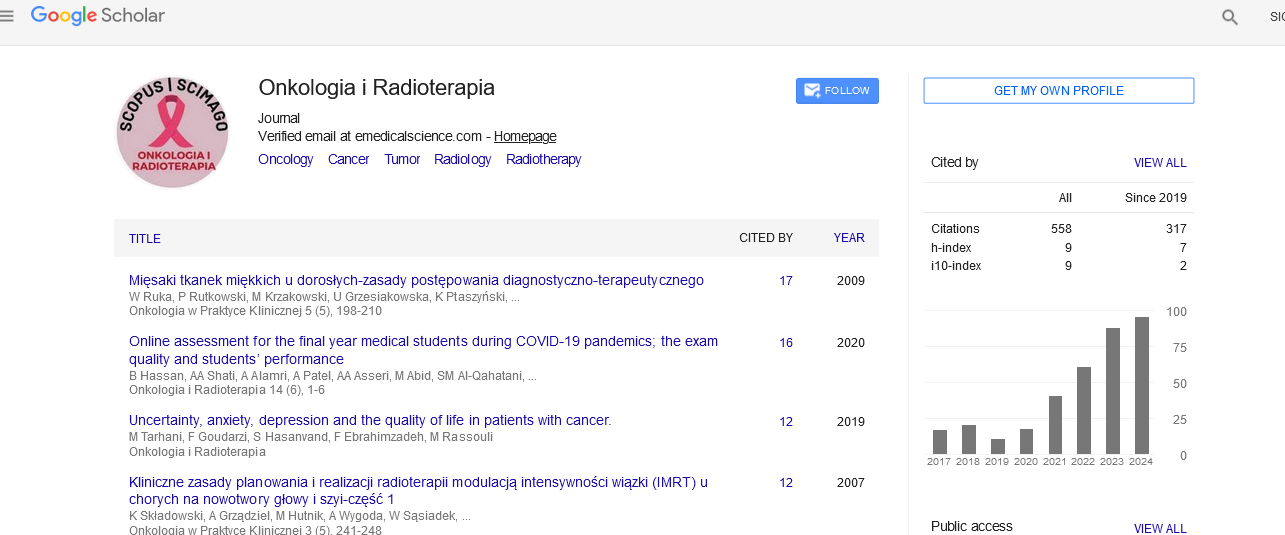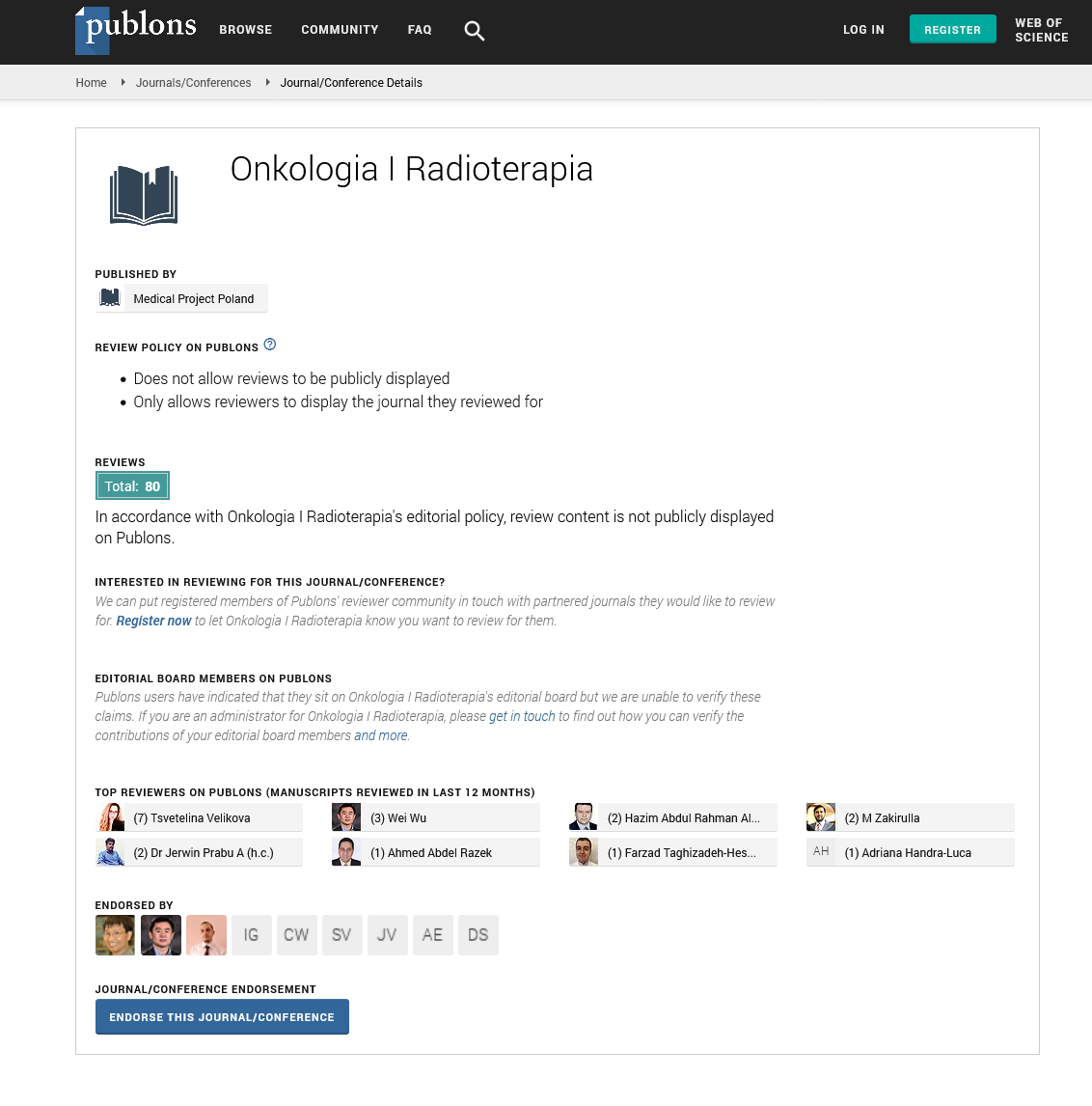Perspective - Onkologia i Radioterapia ( 2025) Volume 19, Issue 2
Nano revolution: Transforming cancer therapy with precision medicine and nanotechnology
Simon Franzen*Simon Franzen, Department of Medicine, University of Amsterdam, 1012 WP Amsterdam, Netherlands, Email: franzensimone@gmail.com
Received: 14-Nov-2023, Manuscript No. OAR-23-120056; , Pre QC No. OAR-23-120056 (PQ); Editor assigned: 16-Nov-2023, Pre QC No. OAR-23-120056 (PQ); Reviewed: 16-Jan-2024, QC No. OAR-23-120056; Revised: 07-Jan-2025, Manuscript No. OAR-23-120056 (R); Published: 14-Jan-2025
Introduction
The latest phase of precision medicine has been established by the combination of nano technology and medicine, which has led to creative ways in cancer therapy. Nanoparticles, with their unique properties, offer a platform for targeted drug delivery, imaging, and diagnostics. This commentary explores the transformative potential of nanotechnology in cancer therapy, from enhancing treatment efficacy to minimizing side effects, and the promising future it holds for patients and clinicians alike.
The promise of targeted drug delivery
Traditional cancer treatments, such as chemotherapy, often lack specificity, affecting both cancerous and healthy cells. These minuscule carriers can be engineered to encapsulate chemotherapy drugs, guiding them directly to the tumor site while sparing healthy tissues. This targeted drug delivery minimizes systemic exposure, reducing side effects and enhancing the therapeutic index.
Particles can exploit the unique characteristics of tumors, such as their leaky vasculature and impaired lymphatic drainage. This Enhanced Permeability and Retention (EPR) effect allows nanoparticles to preferentially accumulate in tumors, a phenomenon that conventional drugs find challenging to replicate. By leveraging the EPR effect, nanotechnology enables a more precise and efficient delivery of therapeutic agents to cancer cells.
Description
Overcoming drug resistance
One of the formidable challenges in cancer therapy is the development of drug resistance, where cancer cells evolve to evade the effects of treatment. Nanoparticles provide a versatile platform to address this issue. Through surface modifications and functionalization, nanoparticles can carry multiple drugs with distinct mechanisms of action, effectively circumventing resistance mechanisms. Additionally, the ability to encapsulate both hydrophobic and hydrophilic drugs within the same nanoparticle enhances the therapeutic arsenal against resistant cancer cells.
The synergy between different therapeutic agents, such as chemotherapy drugs and immunotherapeutics, can be finely orchestrated within nanoparticles to maximize their impact on cancer cells.
Imaging and diagnostics at the nanoscale
Beyond drug delivery, nanotechnology plays a pivotal role in cancer diagnostics and imaging. Quantum dots, for instance, emit distinctive colors when exposed to light, providing a powerful tool for precise imaging at the molecular level.
Moreover, the integration of nanoscale imaging agents with advanced imaging modalities, such as Magnetic Resonance Imaging (MRI) and Positron Emission Tomography (PET), enhances the accuracy of cancer diagnosis and monitoring. Real-time imaging at the nanoscale not only aids in the early detection of tumors but also enables clinicians to assess treatment responses with unprecedented detail.
Challenges and considerations
While the potential of nanotechnology in cancer therapy is vast, challenges and considerations exist. The biocompatibility and safety of nanoparticles, especially as they interact with the human body over time, are critical aspects that require thorough investigation. Understanding the long-term effects of nanoparticle exposure and the potential for bioaccumulation is essential to ensure the safety of these innovative therapies.
Additionally, the scalability and cost-effectiveness of nanoparticle production are practical concerns that need to be addressed for widespread clinical adoption.
Moreover, the convergence of nanotechnology with other cutting- edge fields, such as immunotherapy and gene therapy, opens new avenues for synergistic treatments. By combining the strengths of these diverse approaches, researchers aim to develop comprehensive therapeutic strategies that address the complexities of cancer at multiple levels.
Conclusion
Nanotechnology in cancer therapy represents a paradigm shift in how we approach the diagnosis and treatment of this formidable disease. The precision and versatility offered by nanoparticles hold the key to minimizing side effects, overcoming drug resistance, and ushering in a new era of personalized medicine. As researchers continue to unravel the complexities of cancer biology, nanotechnology stands as a beacon of hope, offering innovative solutions that may redefine the future landscape of cancer therapy. The journey from the nanoscale to the bedside is ongoing, but the transformative potential of nanotechnology in cancer therapy is already leaving an indelible mark on the trajectory of medical science.



